Technology Transfer
As one of the original regenerative medicine companies, AlloSource has been harnessing the power of living cells found naturally in allografts since 1994. We are inspired by Doing More With Life, so we can provide the products necessary to advance patient healing.
FLOWABLE MATRIX COMPOSITIONS AND METHODS
Abstract: Flowable matrix compositions and methods of their use and manufacture are provided. Exemplary compositions may include a flowable, syringeable, putty-like form of acellular human dermal matrix. In some cases, compositions may include a moldable acellular collagen extracellular matrix. In use, the matrix compositions can be used to fill or treat skin voids, channel wounds, and other soft tissue deficiencies.
ALLOGRAFTS COMBINED WITH TISSUE DERIVED STEM CELLS FOR BONE HEALING
Abstract: There is disclosed a method of combining mesenchymal stem cells (MSCs) with a bone substrate. In an embodiment, the method includes obtaining tissue having MSCs together with unwanted cells. The tissue is digested to form a cell suspension having MSCs and unwanted cells. The cell suspension is added to the substrate and the MSCs are allowed to adhere. The substrate is rinsed to remove unwanted cells. In an embodiment, there is disclosed an allograft product including a combination of MSCs with a bone substrate made according to the described method. Other embodiments are also disclosed.
MULTI-PIECE MACHINE GRAFT SYSTEMS AND METHODS
Abstract: Embodiments of the present invention encompass graft assemblies, and methods for their use and manufacture. An exemplary bone graft assembly includes first and second bone pieces having respective mating features which, when combined, define non-uniform press fit. Related embodiments encompass graft assemblies having enclosed or hidden mating features.
CRANIAL CLOSURE DEVICE
Abstract: The design for a cranial closure device, as shown and described.
COMPOSITE BONE CONSTRUCTS AND METHODS
Abstract: Embodiments of the present technology include a graft for administration at a treatment site of a patient. The graft may include a human cadaveric bone material bonded together with a polymeric binder. The human cadaveric bone material may include demineralized bone particles. The demineralized bone particles may have an average diameter less than 1.1 mm, less than 750 .mu.m, less than 500 .mu.m, or less than 250 .mu.m. The human cadaveric bone material may include non-demineralized bone, cancellous bone, and/or cortical bone in embodiments. In some embodiments, bone from animals other than humans may be used, and the patient may be an animal other than a human.
SYSTEM AND METHOD FOR MEASURING A NON-BONE TENDON
Abstract: There is disclosed a system and method for measuring the diameter or thickness of a tendon. In an embodiment, the device includes an adjustable tube having a variably sized cross-sectional diameter in a direction perpendicular to an axis extending between the first end and the second end, the adjustable tube being positionable from an open configuration in which the variably sized cross-sectional diameter is larger than a diameter of a tendon so as to allow loading of the tendon, to a closed configuration in which the variably sized cross-sectional diameter approximates the diameter of the tendon so as to allow measurement of the tendon. The device includes a measurement gradient in operable configuration with the adjustable tube so as to allow measurement of the tendon in the closed configuration. Other embodiments are also disclosed.
STERILE WATER DISPERSION SYSTEM FOR ALLOGRAFT PREPARATION AND PROCESSING
Abstract: There is disclosed a system and method for dispersing sterile water from a circulating high-purity water system to a processing field containing allograft tissue. One embodiment includes a fluid inlet that is fluidly coupled with and configured to receive sterile water from the water system. The dispersion system also includes at least first and second fluid outlets that are selectively operable to deliver respective first and second fluid streams into different areas of the processing field. At least one of the first and second fluid outlets may be associated with a regulator valve configured to provide an adjustable flowrate to conserve water pulled from the circulating water system to meet the needs of the application taking place within the processing field. Other embodiments are also disclosed.



